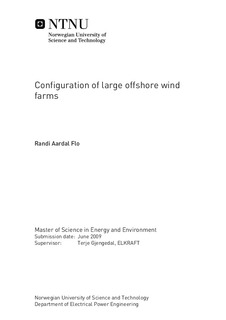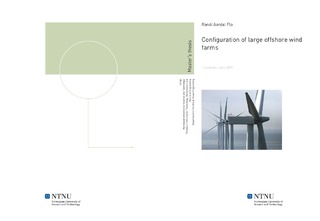| dc.description.abstract | This master thesis is written at the Department of Electric Power Engineering at the Norwegian University of Science and Technology. The work has been carried out at NTNU in Trondheim. The thesis deals with configuration of large offshore wind farms and transmission systems, and is a continuation of the project written during the autumn 2008. Today several plans on 1000 MW offshore wind farms exists. The size of the wind farms has led to a challenge of how to find an efficient and secure design of the overall system. The system has to be cost-effective in order to compete with other forms of power generation. In this study, costs is not considered. The purpose of this thesis was to study different transmission systems and configuration of an 1000 MW wind farm located 75 km from shore. The optimal distance between the turbines is a compromise between wake effect, wind farm are and cable lengths. To perform a detailed study of wake effects and optimal spacing, computer programs like WindSim would be necessary. Three common wind farm configurations is radial, star and ring layout. The selection of layout depends on costs, wind data and the wind farm area. Various wind turbine systems have been developed and different wind generators have been built. According to the survey of different wind generator system and considering the grid connection requirements on wind turbines, the developing trends of wind turbine generator systems shows that variable speed is very attractive and concepts with full-scale power converters will become more attractive. In this thesis two wind farm configurations with different transmission system were further studied. AC/AC, AC/DC and DC/DC are possible transmission systems. In this thesis AC/AC and AC/DC were compared. The selected layout of the wind farm was the radial layout. Number of strings was 35, with eight turbines in each string. Each wind turbine could produce 3.6 MW, which gives a total generation of 1008 MW. The two configurations were modeled in PSS/E. Siemens has made a model called WT3 that was developed to simulate performance of a wind turbine employing a doubly fed induction generator (DFIG). The model was developed in close cooperation with the GE Energy modeling team. This model was used in this thesis. For the dc transmission the HVDC Light from ABB was used. Two different disturbances were applied. One at the connection point at shore, and one at the connection point for all the radials. The load flow results shows that the losses are 5.8$%$ higher in the AC/DC system. The dynamical result shows that both of the systems were stable, and fulfill the grid code requirements. The results indicates that the short-circuit MVA is higher in the ac system than in the dc system. After a fault the voltage recovery was more smoother in the dc system, and the voltage recovery time were shorter. | nb_NO |

